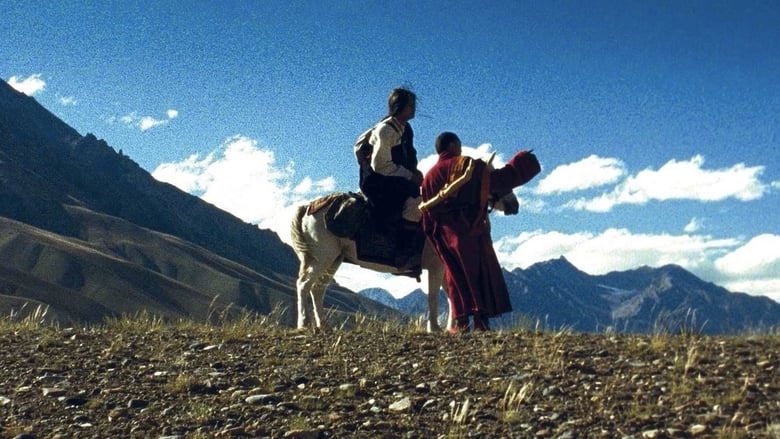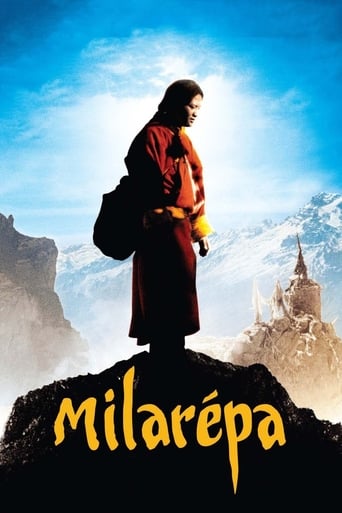Milarepa depicts the humble beginnings of the man who was to become Tibet's greatest saint. A true story based on centuries-old oral traditions, a youthful Milarepa is propelled into a world of sorrow and betrayal after his father's sudden death. Destitute and hopeless, he sets out to learn black magic - and exact revenge on his enemies - encountering magicians, demons, an enigmatic teacher and unexpected mystical power along the way. But it is in confrontation with the consequences of his anger that he learns the most. Photographed in the stunning Lahaul-Spiti region of Northern India, Milarepa offers a provocative parallel to the cycle of violence and retribution consuming today's world.
Reviews
An Exercise In Nonsense
The plot isn't so bad, but the pace of storytelling is too slow which makes people bored. Certain moments are so obvious and unnecessary for the main plot. I would've fast-forwarded those moments if it was an online streaming. The ending looks like implying a sequel, not sure if this movie will get one
The tone of this movie is interesting -- the stakes are both dramatic and high, but it's balanced with a lot of fun, tongue and cheek dialogue.
The story, direction, characters, and writing/dialogue is akin to taking a tranquilizer shot to the neck, but everything else was so well done.
"If you are many, make war. If you are few, make sorcery!" 'Milarepa' is a film adaptation of one of Tibet's most famous ancient legends, based loosely upon the life and teachings of a Buddhist yogi and poet (in his youth known as Thöpaga) who lived in the 11th Century. Born to wealthy parents, Thöpaga's father dies young, allowing his greedy siblings to spirit away the family inheritance. Near-destitute, Thöpaga and his mother struggle to eke out a living until the mother eventually snaps and compels her son to learn sorcery so as to inflict revenge on their malefactors. However, the boy quickly discovers that revenge comes with its own price. This film chronicles the early years of this now-revered figure, and is very much within the fantasy genre, playing as it does with the myths and the melodrama surrounding the character, though his principal teachings sit at the core of the plot, which have been a source of inspiration to generations. New to the tale of Milarepa, I found myself generally enjoying this big-screen retelling, despite certain issues I had with its execution.It seemed fairly apparent that this is a film preaching to the choir, as it were, with many sequences flying along as if obligatory shorthand for an audience already familiar with the story, but a little too rushed for anyone else. To those unfamiliar, the early sections of the film in particular seem like edited highlights that required more time and build-up to achieve maximum impact. For example, the introduction where Thöpaga's father dies and the siblings show their true colours is a very few minutes in length and family ruin consequently achieved at a whirlwind pace. Storywise, the key elements are intact, but the sometimes choppy pacing and rapid jumps forward in time prevent sufficient character development, an essential process in lending believability to what is after all pure fantasy. It's clear that director Neten Chokling is keen to get to the sorcery element, thereby relying on several sequences of over-the-top melodrama within the family to sell the desire for revenge. Again, if you're familiar with the story and know what's coming, this is doubtless not such a problem.Indeed, once Thöpaga does set off on the road on his voyage of discovery, the fantasy element really takes over and the adventure begins in earnest. All throughout 'Milarepa', the audience is treated to some truly breathtaking Himalayan scenery – surely one of the most dramatic landscapes on earth. Here at the Roof of the World, it truly does seem as though magic could determine the fates of man, and the backdrop does much to sell the story. Yogic strongholds sit precariously atop mountains and seem to dominate the magnificent valleys below. Here, Thöpaga must travel to seek the otherworldly skills that will let him inflict revenge, which his masters seem quite keen to impart. It almost seems irresponsible, yet Buddhism is after all about passing on knowledge rather than judging how the beholder will use it.After all, while mastery of the self is the Buddhist philosophy, 'Milarepa' is very much about karmic retribution, which its central character painfully learns must flow in both directions. The 'sorcery' of the film is realised through a surprising amount of cgi that takes the film very much into cartoon territory, but this is after all a retelling of the legend rather than a biopic, and if you're going to delve into the mythology, you may as well go all the way. Perhaps because the earlier scenes had been so 'comic book' in structure, I found myself very much in the right frame of mind when the visual effects appeared and if anything, this is where my enjoyment properly set in.It does mean that those hoping for a deeply spiritual Buddhist epic on the folly of conflict will be disappointed – the message is there intact, but in very much the same way that it was in 'Monkey Magic'. Whether or not this makes Jamyang Lodro's portrayal of the young Thöpaga a little too close to Hayden Christiansen's Anakin Skywalker is up to the viewer to decide, as is the question of whether or not Chokling's approach to his subject matter is out of a desire to make 'Milarepa' into Tibet's answer to Tolkien. Either way, Lodro plays the troubled youth convincingly and is helped by several other good performances, most notably Orgen Tobgyal, as his willing yogic master - apparently also the film's art director.Thöpaga's real-life alter ego would famously recount years later that he had been very foolish in his youth and faced a long path to wisdom ('How senseless to disregard one's life by fighting foes who are but frail flowers'). His voyage to maturity and enlightenment is purportedly the focus of the sequel, which at this stage, is long overdue. This therefore means that 'Milarepa' does not have a strong ending - so much of the story is yet to be told, and hopefully Chokling will succeed in bringing it to light. In that event, 'Milarepa' will doubtless be better evaluated as simply the opening chapter of a much larger tale – one of reckless youth, in which mistakes are made that lead to wisdom in the wise. This does not absolve it of its cartoon fantasy leanings, but as my introduction into the world of this highly celebrated Tibetan spiritual leader, it was an entertaining enough ride.
Milarepa the movie is the first of a series of two. It depicts the legend of Milarepa. It's filmed in Tibet - among the all-present towering mountain ranges, which makes the sky and heavens seem so close, and shot in the Tibetan tongue. Both things - combined with the delicate portrait of the people and the culture, and the quiet yet captivating development in this beautiful movie, makes it a movie of grace, a bit of wonder, and of visual beauty. It's a silence in this movie, which touched my heart.Concerning the content, this depicts the first part of Milarepa's journey into spirituality, as it is interpreted in the popular legends of Tibet. I won't reveal too much, but this movie depicts his family, the harshness of life in Tibet, the upbringing of Milarepa, and the pains they had to undergo. And the way all this shot Mila (he first became -repa, when he became a lama; -repa being the suffix designating this) into the violent world of adulthood, realizing the sufferings of this world for himself.The second part to come in this series, depicts Milarepa's life as a lama, I believe.The movie may be a bit slow in its out-folding, and a bit "lacking" in its contents; it has its flaws. But for my part these shortcomings were filled by how the splendor which the themes of the movie, which are very dear to me, was wonderfully spilled out.
Milarepa (2006) is an interesting Tibetan film chronicling segments from the life of a Tibetan yogi, Thopaga / Milarepa, who lived in the 11th century in western Tibet, who was born into a wealthy family but on the death of his father, was robbed of his inheritance by his father's greedy family. His mother complains about suffering throughout the film but to the viewer, she really doesn't have it that bad, it seems like she only longs for more wealth. Hence the universal themes of vengeance and yearning dictate her motives and disposition. She influences her son Thopaga / Milarepa to study sorcery to inflict revenge on his father's greedy family, leaving his female companion, who is quite beautiful.The first half of the film is quite good and simple in nature, familiar conflicts play a vital theme. The landscape is absolutely stunning and the low key, natural realism of the actors is very momentous.The film loses some of its impetus when it delves into silly Computer-generated imagery during the sorcery scenes. These could have been left out altogether, and insinuations, inferences, and basic camera tricks would have sufficed much better to keep it resembling an elementary human drama. The silly Computer-generated imagery knocks the sorcery scenes down to a "sword and sorcery" Hollywood look-alike.I enjoyed it though and it was capable if you are intrigued by foreign films. In all, it is an above average film that imparts a universal common, human leitmotif, that is of human meaning and human predicaments.
Milarepa, the first feature by Neten Chokling Rinpoche, tells the story of the formative years of Milarepa, an 11th century Tibetan poet and mystic and his journey from seeking revenge to enlightenment. Set in the magnificent Spiti Valley close to the border between India and Tibet, the film has spectacular cinematography and convincing performances from a cast that includes Jamyang Lodro, the obstreperous football-obsessed youngster in The Cup as Thopaga, the young Milarepa. The cast and crew also include monks from the Pema Ewam Choegar Gyurmeling Monastery in India and Tibet of which Chokling Rinpoche is the spiritual head. In the process of making the film, Chokling took in some 40 destitute young boys, many of them orphans, and used his film to help feed, house, and care for the boys. Milarepa (1052-1135) is one of the most widely known Tibetan Saints. According to a blessing Milarepa uttered towards the end of his life, anyone who but hears the name Milarepa even once attracts an instant blessing and will not take rebirth in a lower state of existence during seven consecutive lifetimes. In Part One of Chokling Rinpoche's biography, Thopaga, which means delightful to hear, grows up in a happy and prosperous environment. His father is wealthy in relation to the other villagers and the family lives in a large stone house consisting of three stories held in place by a large central pillar and supporting columns. When his father, Mila-Dorje-Senge, is near death, he calls the family together to inform them that he has placed his entire estate in the care of Thopaga's Uncle Gyalsten (Gonpo) and Aunt Peydon (Tsamchoe) until Milarepa was grown and married to Zesay, his arranged partner. Happiness and wealth is not to be for Milarepa, however, as his Aunt and Uncle divide the estate between them and force Milarepa and his mother Kargyen (Kelsang Chukie Tethong) and sister Peta to work in the fields. The family, once the envy of the village, now become objects of derision. Using Thopaga (Milarepa) as an instrument of revenge, his mother sells some property to raise money to send the young boy to study with Lama Yongten Troygal (Orgyen Tobgyal), known to be adept in the arts of sorcery and black magic. Using sorcery learned from masters, he exacts revenge on his Aunt and Uncle by producing a storm that brings death and destruction to his own people, but it is a Pyrrhic victory and leaves Thopaga in a state of remorse for his evil deeds. His transformation from revenge seeker to inspired saint will be the subject of the second part of the series, scheduled for release in 2009.Milarepa has all the entertainment value of The Cup and Travellers and Magicians, plus it is filled with Buddhist spiritual teaching that is never heavy-handed. As Chokling Rinpoche states, "His (Milarepa) story shows that the path to enlightenment is accessible to all and can be anyone's aspiration and realization". Chokling's production company, Shining Moon Productions, is now showing the film in festivals, a series of benefit screenings hosted by Sharon Stone, and limited commercial engagements. A DVD release is scheduled for November. After recovery of the film costs, Neten Chokling has pledged to use proceeds for the benefit of his orphans and monks. Highly recommended.
Top Streaming Movies














